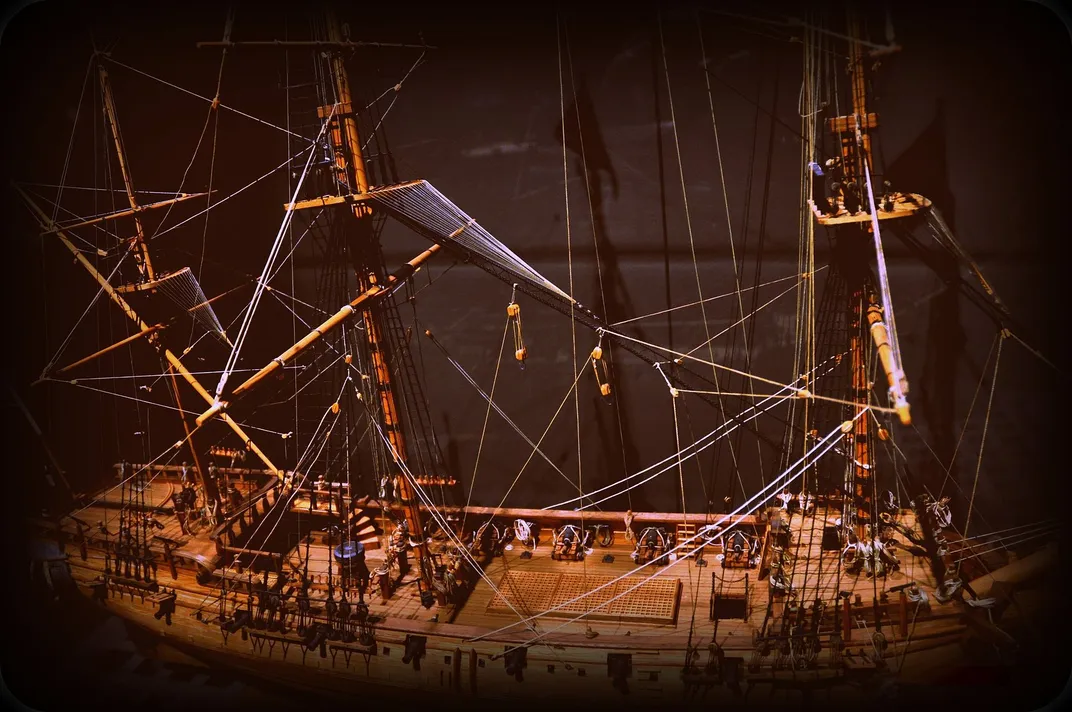Six Skeletons Found in Wreck of 18th-Century Pirate Ship Sunk Off Cape Cod
The “Whydah” sank off the coast of Massachusetts in 1717, killing all but two people on board
:focal(443x379:444x380)/https://tf-cmsv2-smithsonianmag-media.s3.amazonaws.com/filer/25/2c/252c6edc-fb7a-4e75-b782-1d3ab6de46c4/121287480_4710478875659432_6615919483319535209_o.jpg)
Archaeologists in Cape Cod have recovered six skeletons from the ruins of the Whydah, a British pirate ship that sank during a 1717 storm with 146 men—and a trove of treasures—on board.
As CBS News reports, a team led by Barry Clifford, who discovered the wreck in 1984, found the remains inside huge concretions, or rigid masses that form around underwater objects. Experts at the Whydah Pirate Museum in West Yarmouth, Massachusetts, now plan to examine the skeletons in further detail.
“We hope that modern, cutting-edge technology will help us identify these pirates and reunite them with any descendants who could be out there,” says Clifford in a statement quoted by CBS News.
According to Marie Szaniszlo of the Boston Herald, the team unearthed one complete skeleton and portions of five other sets of remains. Some of the bones had been broken, likely when the ship capsized, crushing its passengers.
This isn’t the first time that archaeologists have recovered human remains from the wreck. In 2018, researchers from the museum compared DNA from one of Whydah Captain Samuel “Black Sam” Bellamy’s descendants to a leg bone found in the wreck. As Jason Savio reported for the Cape Cod Times that May, the analysis suggested that the femur’s owner was a man with Eastern Mediterranean ties, not the fearsome captain in question.

Discovered embedded in a concretion, the anonymous pirate died with a pistol in his hand and metal—likely gold—stashed in his pocket, Clifford told the Times.
“It appears that this person was killed by a 400-pound roll of lead that’s encapsulated within the concretion,” the archaeologist added, “and you can see that the lead was right on top of his skeleton.”
Though this hapless individual turned out not to be Bellamy, the “newly found skeletal remains may finally lead us to [him],” says Clifford in the statement, as quoted by Travis Andersen of the Boston Globe.
The only authenticated pirate wreck in the world, the Whydah boasts a storied history. As Kristen Young wrote for the Cape Cod Times in 2018, the ship sank off the coast of Wellfleet during an April 26, 1717, nor’easter, killing all but two of the 146 people on board. The bodies of 101 crew members eventually washed up on the beach, but another 43—including Bellamy—seemingly went down with the ship.
Born in western England around 1689, Bellamy was one of the wealthiest pirates of all time, stealing an estimated $145 million (when adjusted for inflation) before his death at age 28, according to data compiled by Forbes’ Matt Woolsey.
Per the Field Museum, Bellamy’s crew was made up of enslaved Africans, Native Americans, and sailors from across Europe and North America. Originally a British slave ship, the vessel was captured by Bellamy in early 1717.
The New England Historical Society notes that the captain treated all crew members equally, allowing them to vote on significant decisions. Bellamy, who nicknamed himself “Robin Hood of the Sea,” viewed his piracy as a form of vigilante justice against wealthy merchants who “rob[ed] the poor under the cover of law.” To retaliate, he once declared in a speech, “[W]e plunder the rich under the protection of our own courage.”
In the statement, as quoted by WPRI’s Melanie DaSilva, Clifford says, “This shipwreck is very sacred ground.”
He adds, “We know a third of the crew was of African origin and the fact they had robbed the Whydah, which was a slave ship, presents them in a whole new light. Their benevolent captain, the legendary Samuel ‘Black Sam’ Bellamy, and crew were experimenting in democracy long before the so-called civilized societies had considered such a thing.”
Artifacts previously recovered from the wreck include 15,000 coins; weapons such as a three-pound, .56 caliber pistol; tools; shackles; and gemstones.
According to the museum’s website, “At the time of the wreck, [the ship] was carrying … valuables from over 50 other ships captured by Bellamy’s pirates. The Whydah collection, therefore, represents an unprecedented cultural cross-section of material from the 18th century.”
/https://tf-cmsv2-smithsonianmag-media.s3.amazonaws.com/accounts/headshot/Isis_Davis-Marks_thumbnail.png)
/https://tf-cmsv2-smithsonianmag-media.s3.amazonaws.com/accounts/headshot/Isis_Davis-Marks_thumbnail.png)